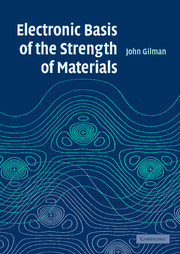Preface
Published online by Cambridge University Press: 14 August 2009
Summary
In the middle of the twentieth century it was recognized that the theory of the mechanics of continua (particularly solid mechanics) is not adequate to account for the strength properties of materials. It was clear that structural considerations at the microscopic and nanoscopic levels of aggregation are not only important but are essential to an understanding of the strengths of materials. It also came to be realized, as a result of the fact that plastic shear deformation is usually heterogeneous, that a space can be continuous but not simply connected, that is, dislocated. Also, in crystals, such dislocations are quantized, having constant displacements equal to the magnitudes of translation vectors of the crystal structure.
Although structural geometry plays an essential role in determining mechanical behavior, it leaves a number of questions unanswered. The answers to these questions can only be found by considering the electronic structure that underlies the geometric factors. Since the behavior of electrons is not described by classical mechanics, this necessitates the use of quantum mechanics to obtain answers to the various unanswered questions. For example, why is the shear stiffness of diamond greater than its volumetric stiffness? Why do the most simple metals, the alkalis, have body-centered cubic crystal structures which are not atomically close packed? Why is pure silicon brittle, while pure nickel is quite ductile? They both have the same crystal structure, so why is pure TiC hard, while pure NaCl is soft?
- Type
- Chapter
- Information
- Electronic Basis of the Strength of Materials , pp. ix - xPublisher: Cambridge University PressPrint publication year: 2003



